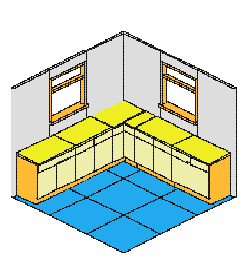Kitchen Surfaces: Difference between revisions
From DT Online
(Added Template) |
mNo edit summary |
||
| Line 5: | Line 5: | ||
=====Description===== | =====Description===== | ||
Floors and walls need special thought when planning a kitchen. Floors need to be easily cleaned, non-slippery and also comfortable and quiet to walk on. Walls should be easy to wipe clean and in areas behind taps, tiled or | Floors and walls need special thought when planning a kitchen. Floors need to be easily cleaned, non-slippery and also comfortable and quiet to walk on. Walls should be easy to wipe clean and in areas behind taps, tiled or '''[[Laminate]]''' splash-backs are needed. | ||
| Line 17: | Line 17: | ||
* [https://en.wikipedia.org/wiki/Cork_%28material%29 '''Cork tiles'''] - these can be used on floors and walls; dense tiles are best for floors. Some have a surface layer of transparent vinyl. | * [https://en.wikipedia.org/wiki/Cork_%28material%29 '''Cork tiles'''] - these can be used on floors and walls; dense tiles are best for floors. Some have a surface layer of transparent vinyl. | ||
* [https://en.wikipedia.org/wiki/Tile#Floor_tiles '''Clay/ceramic tiles'''] - there are two types: [https://en.wikipedia.org/wiki/Quarry_tile '''clay floor quarries'''] and [https://en.wikipedia.org/wiki/Tile#Floor_tiles '''ceramic floor tiles''']. Ceramics are made to a closer tolerance, have a smoother finish, are glazed and absorb less water. | * [https://en.wikipedia.org/wiki/Tile#Floor_tiles '''Clay/ceramic tiles'''] - there are two types: [https://en.wikipedia.org/wiki/Quarry_tile '''clay floor quarries'''] and [https://en.wikipedia.org/wiki/Tile#Floor_tiles '''ceramic floor tiles''']. Ceramics are made to a closer tolerance, have a smoother finish, are glazed and absorb less water. | ||
* | * '''[[Laminate|Laminate Flooring]]''' - flooring laminates are manufactured around a core of '''[[Manufactured Board|fibreboard]]''' which has a printed decorative layer on top and a protective, moisture proof, bottom backing layer of [https://en.wikipedia.org/wiki/Melamine_resin '''melamine''']. The edges are accurately machined enabling them easily to click together to form a complete [https://en.wikipedia.org/wiki/Floating_floor '''floating floor''']. | ||
* [https://en.wikipedia.org/wiki/Wood_flooring#Engineered '''Engineered Wood Flooring'''] - these have a top surface of natural timber which is usually bonded onto a '''[[Manufactured Board|fibreboard]]''' core. Alternatively a softwood core may be used and the flooring built up in layers with alternative grain directions to keep it stable. | * [https://en.wikipedia.org/wiki/Wood_flooring#Engineered '''Engineered Wood Flooring'''] - these have a top surface of natural timber which is usually bonded onto a '''[[Manufactured Board|fibreboard]]''' core. Alternatively a softwood core may be used and the flooring built up in layers with alternative grain directions to keep it stable. | ||
* [https://en.wikipedia.org/wiki/Wood_flooring '''Solid Wood Flooring'''] - accurately machined strip of natural wood usually '''[[Widening Joint|Tongued and Grooved]]''' and often with grooves cut into the back of the wood running the length of each plank to minimise any tendency for the wood to '''''cup''''' or curl up in some way. | * [https://en.wikipedia.org/wiki/Wood_flooring '''Solid Wood Flooring'''] - accurately machined strip of natural wood usually '''[[Widening Joint|Tongued and Grooved]]''' and often with grooves cut into the back of the wood running the length of each plank to minimise any tendency for the wood to '''''cup''''' or curl up in some way. | ||
Latest revision as of 09:47, 27 August 2017
Description
Floors and walls need special thought when planning a kitchen. Floors need to be easily cleaned, non-slippery and also comfortable and quiet to walk on. Walls should be easy to wipe clean and in areas behind taps, tiled or Laminate splash-backs are needed.
Features and Applications
Before covering, concrete floors should be checked that they are sound. Slight unevenness can be cured by using a self-levelling compound. Wooden floors should be checked for rot, loose boards fixed, and protruding nails and screws removed. Uneven floors should first be covered with a layer of Hardboard, rough side up, Chipboard or MDF if Ceramic or Porcelain tiles are to be used to cover it.
Concrete floors can be painted and wooden floors sanded and sealed but more usually one of the following coverings is used:
- Vinyl floor covering or cushioned vinyl - this is still often referred to as linoleum or lino. It comes in a range of patterns and colours and in 2m, 3m and 4m widths off the roll. The patterns are printed underneath a thin transparent PVC layer.
- Cork tiles - these can be used on floors and walls; dense tiles are best for floors. Some have a surface layer of transparent vinyl.
- Clay/ceramic tiles - there are two types: clay floor quarries and ceramic floor tiles. Ceramics are made to a closer tolerance, have a smoother finish, are glazed and absorb less water.
- Laminate Flooring - flooring laminates are manufactured around a core of fibreboard which has a printed decorative layer on top and a protective, moisture proof, bottom backing layer of melamine. The edges are accurately machined enabling them easily to click together to form a complete floating floor.
- Engineered Wood Flooring - these have a top surface of natural timber which is usually bonded onto a fibreboard core. Alternatively a softwood core may be used and the flooring built up in layers with alternative grain directions to keep it stable.
- Solid Wood Flooring - accurately machined strip of natural wood usually Tongued and Grooved and often with grooves cut into the back of the wood running the length of each plank to minimise any tendency for the wood to cup or curl up in some way.








